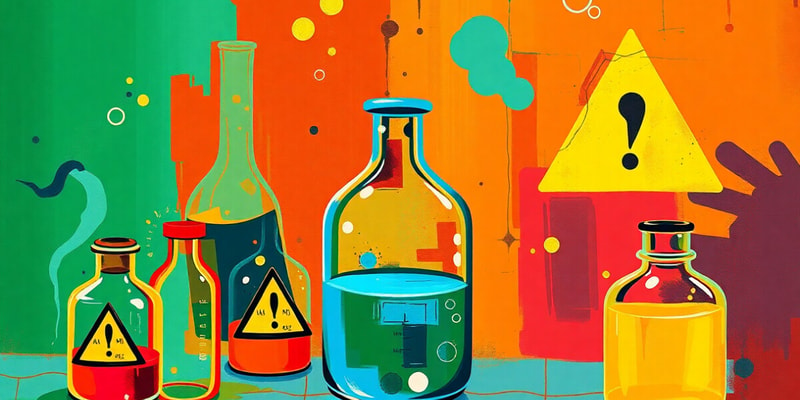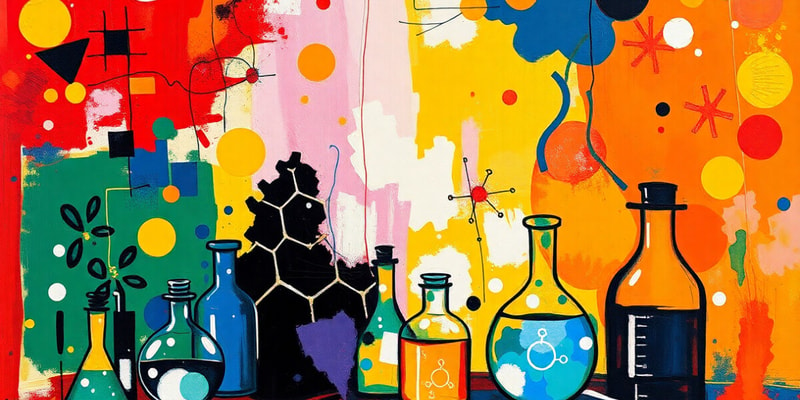Podcast
Questions and Answers
What should you do if there is a spill or an accident during an experiment?
What should you do if there is a spill or an accident during an experiment?
Which of the following should be worn to protect against exposure to harmful substances?
Which of the following should be worn to protect against exposure to harmful substances?
How should broken glassware be disposed of?
How should broken glassware be disposed of?
When heating a test tube, which direction should the open end be pointed?
When heating a test tube, which direction should the open end be pointed?
Signup and view all the answers
What is the initial step to take in case of a burn in the laboratory?
What is the initial step to take in case of a burn in the laboratory?
Signup and view all the answers
Which safety gear is NOT typically necessary when handling chemicals?
Which safety gear is NOT typically necessary when handling chemicals?
Signup and view all the answers
Before starting your experiment, you should:
Before starting your experiment, you should:
Signup and view all the answers
Which statement is true regarding the handling of hot objects in the laboratory?
Which statement is true regarding the handling of hot objects in the laboratory?
Signup and view all the answers
What is the best action to take while handling chemicals in the laboratory?
What is the best action to take while handling chemicals in the laboratory?
Signup and view all the answers
Which of the following steps is correct when disposing of broken glassware?
Which of the following steps is correct when disposing of broken glassware?
Signup and view all the answers
What precaution should you take when heating glassware?
What precaution should you take when heating glassware?
Signup and view all the answers
In an emergency situation involving burns, what should you NOT do?
In an emergency situation involving burns, what should you NOT do?
Signup and view all the answers
What is a primary rule when mixing chemicals in the laboratory?
What is a primary rule when mixing chemicals in the laboratory?
Signup and view all the answers
Which piece of lab safety equipment is essential for protecting your eyes?
Which piece of lab safety equipment is essential for protecting your eyes?
Signup and view all the answers
How often should you change gloves while conducting multiple experiments?
How often should you change gloves while conducting multiple experiments?
Signup and view all the answers
When should you notify your teacher during a lab session?
When should you notify your teacher during a lab session?
Signup and view all the answers
Study Notes
Laboratory Safety Hazards
- Exposure to blood, body fluids, and specimens can contain pathogenic bacteria and viruses.
- Acids, alkalis, and toxic chemicals pose a risk.
- Ineffective radioactive waste disposal can lead to contamination.
- Fire and electrical accidents are potential hazards.
General Safety Rules
- Read instructions thoroughly before starting an experiment.
- Wear safety goggles to protect eyes from chemicals, heated materials, or projectiles.
- Wear a lab coat, gloves, face mask, and hair cap for protection.
- Wash hands with soap and water after handling chemicals.
- Avoid touching your face during lab work.
- Do not mix chemicals unless instructed to do so.
- Report spills or accidents immediately to a teacher.
- Clean up your lab area after completing an experiment.
Glassware Safety
- Dispose of broken glassware in a designated glass disposal container.
- Ensure glassware is placed on a stable surface at a safe distance from the edge when pouring liquids.
- Inform the teacher if glassware breaks.
Heating Safety
- Use protective gloves when handling hot objects.
- Never reach across an open flame.
- Point the open end of a test tube being heated away from people.
- Heat test tubes slowly and evenly by moving them around the flame.
- Only heat thoroughly dry glassware.
- Use a wire gauze platform on a ring stand to heat glassware, not by hand.
First Aid
- Burns: Immediately flush with cold water.
- Cuts and Bruises: Do not touch open wounds without safety gloves. Apply pressure to minor cuts to stop bleeding. Apply a cold compress to bruises to reduce swelling.
- Eyes: Immediately flush with plenty of water for several minutes.
Laboratory Safety Hazards
- Exposure to blood, body fluids, and specimens carries the risk of pathogenic bacteria and viruses.
- Acids, alkalis, and toxic chemicals are also potential hazards.
- Ineffective radioactive waste disposal can lead to contamination.
- Fires and electrical accidents can occur in the laboratory.
General Safety Rules
- Always read instructions carefully before starting an experiment.
- Wear safety goggles to protect your eyes from chemicals, heated materials, or objects that might shatter.
- Use a lab coat, gloves, face mask, and hair cap for additional protection.
- Wash your hands with soap and water after handling chemicals.
- Avoid touching your face during lab work.
- Never mix chemicals unless explicitly instructed.
- Report any spills or accidents to the teacher immediately.
- Clean up your lab area after completing an experiment.
Glassware Safety
- Dispose of broken glassware in a designated glass disposal container.
- When pouring liquids into glassware, ensure it is positioned on a table at least a hand's breadth from the edge.
- Inform the teacher if any glassware breaks.
Heating Safety
- Use protective gloves to handle hot objects.
- Avoid reaching across an open flame.
- Point the top ends of heated test tubes away from people.
- Heat test tubes slowly and evenly by moving them over the flame.
- Only heat thoroughly dry glassware.
- Use a wire gauze platform on a ring stand to heat glassware, not by holding it directly.
First Aid
- Flush burns immediately with cold water.
- Wear safety gloves before touching an open wound.
- Apply direct pressure to minor cuts to stop bleeding.
- Use a cold compress on bruises to reduce swelling.
- Flush eyes with plenty of water for several minutes if exposed to chemicals.
Studying That Suits You
Use AI to generate personalized quizzes and flashcards to suit your learning preferences.
Related Documents
Description
Test your knowledge on essential laboratory safety protocols, including hazards related to chemical exposure and equipment use. This quiz covers crucial safety rules and best practices to ensure a safe laboratory environment.




